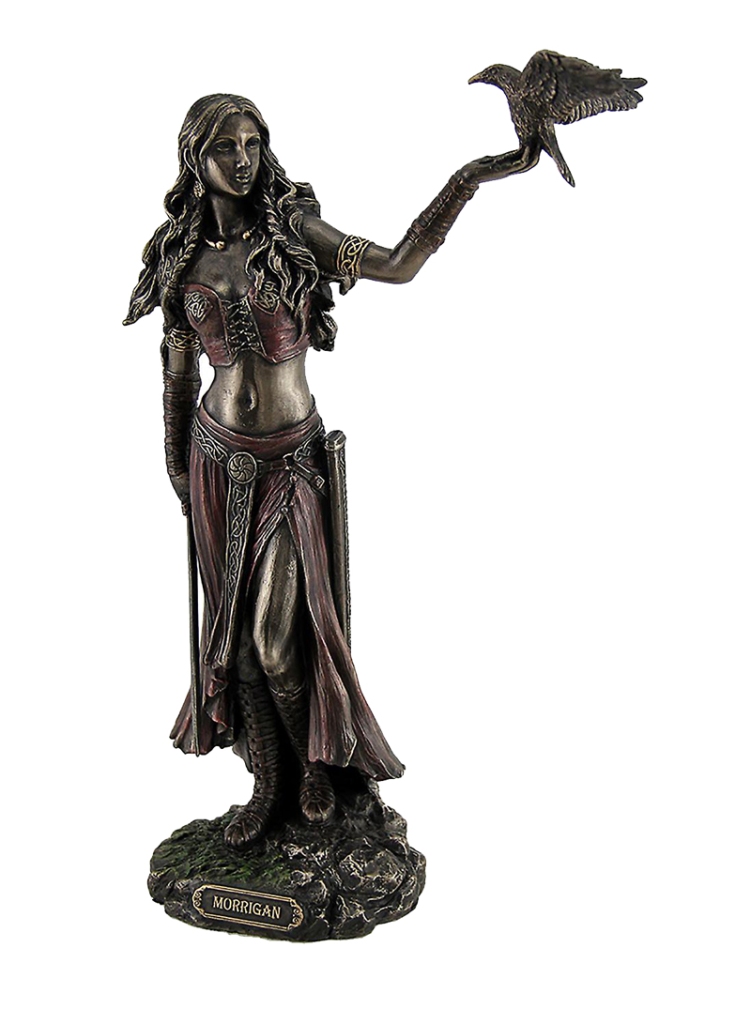Morrigan “Celtic Goddess of Battle Holding Crow and Sword” Statue
This Celtic Goddess Morrigan Statue is an impressively detailed statue depicting the Goddess Morrigan in a flirtatious celtic dress with a crow in her hand standing holding a sword. Expertly crafted of cold cast bronze in strikingly sculpted detail. Mixing bronze powder with resin gives it an authentic metal look with a stunning antique bronze finish and you’ll marvel at the colored effects. The Morrigan is depicted here wearing a daring blue dress, holding a sword and ready for battle. A crow swoops down to perch on the soft landing of her open palm. Her hair is long with 2 braids in the front and worn loose, allowing her wavy tendrils to flow freely. A striking must-have piece rich with celtic symbols and a thoughtful gift for anyone into nature religions. The Morrigan or Mórrígan, also known as Morrígu, is a figure from Celtic Mythology. The name is Mór-Ríoghain in Modern Irish, and it has been translated as “Great Queen” or “Phantom Queen“. The Morrígan is mainly associated with war and fate, especially with foretelling doom, death, or victory in battle. In this role she often appears as a crow, the Badb. She incites warriors to battle and can help bring about victory over their enemies.
The Morrigan encourages warriors to do brave deeds, strikes fear into their enemies, and is portrayed washing the bloodstained clothes of those fated to die. She is most frequently seen as a goddess of battle and war and has also been seen as a manifestation of the earth and sovereignty-goddess, chiefly representing the goddess’s role as guardian of the territory and its people. The Morrigan is often described as a trio of individuals, all sisters, called “The 3 Morrigna“. Membership of the triad varies, sometimes it is given as Badb, Macha, and Nemain while elsewhere it is given as Badb, Macha, and Anand (the latter is given as another name for the Morrigan). It is believed that these were all names for the same goddess. The 3 Morrigna are also named as sisters of the 3 land goddesses Ériu, Banba, and Fódla. The Morrigan is described as the envious wife of The Dagda and a shape-shifting goddess, while Badb and Nemain are said to be the wives of Neit.
She is associated with the banshee of later folklore. In the sources, the name of the Morrigan is always preceded by the definite article (an Mórrígan or an Mórrígu). As for its etymology, it goes back to an older Irish name, Mór Ríoghain, which literally translates as “great queen” (from mór, “great“, and rígan, “queen“). This meaning is the same as the name of the Ancient Indo-European Goddess Rigantona, to whom the name of the Morrigan is sometimes referred to. Alternatively, the first element of Mór Ríoghain can also be identified with the Germanic mahr (“nightmare“, the same root as nightmare), meaning “Queen of Ghosts“. Traditionally, her name was also linked to the Celtic word mor “Sea“, a connection generally rejected by modern linguists, the name of the Fairy Morgana probably goes back to this element, which is sometimes linked to the same Morrigan. Morrigan “Celtic Goddess of Battle Holding Crow and Sword” Statue sizes: 6.5 inches / 16.5 cm x 3 inches / 7.5 cm x 10.25 inches / 26 cm.
Celtic Goddess Morrigan Statue on Amazon.
Celtic Goddess Morrigan Statue on eBay.
Celtic Statues and Gods Statues.




You must be logged in to post a comment.